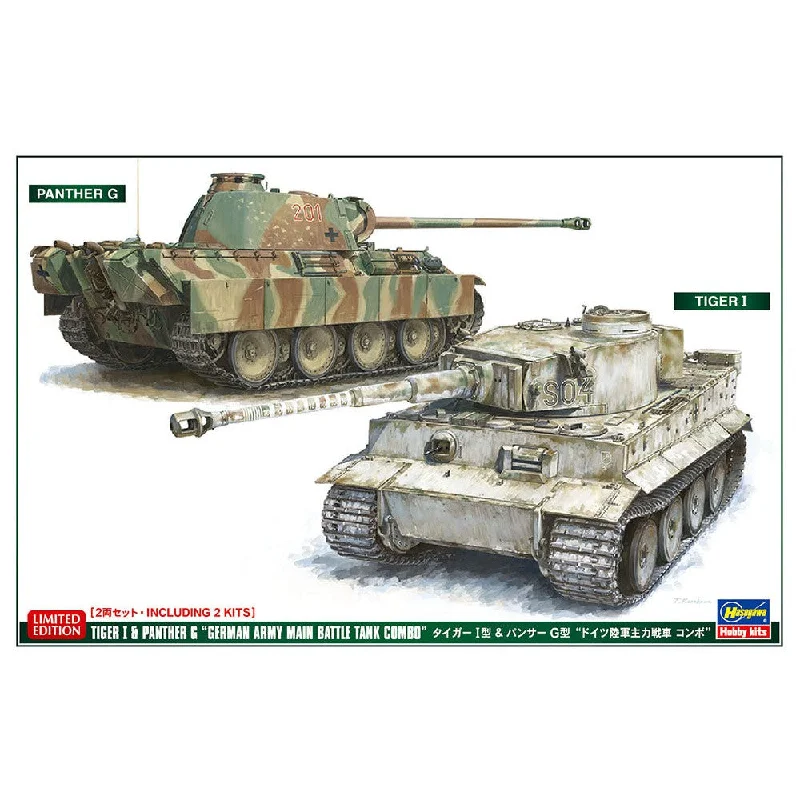The Pz.Kpfw VI (Sd.Kfz.181) Tiger is a German heavy tank from World War II, one of the most famous combat vehicles of that time. The command of the German Panzerwaffe had the idea of creating a heavy tank from the beginning of the war, but the first attempts in the form of the centuries-old Neubaufahrzeuge tank turned out to be unsuccessful. In 1939 and 1940 they were conducted ineffectively, but after the clash with the T-34 and KW-1 on the eastern front, work on the new heavy tank sped up. On April 20, 1942, the prototype of the new tank, under the designation VK 4501 (H), underwent field trials in the presence of Adolf Hitler and was put into mass production shortly after. The first production versions were designated Pz.Kpfw VI Ausf.H1 (later Ausf.E). In the course of production, in the years 1942-1945, the tank was systematically modified by, for example, adding Feifell dust filters, different placement of headlights, modernization of optical equipment, changes to the commander's turret, etc. The drive was provided by a Maybach HL230 P45 12-cylinder carburetor engine with a capacity of 700 HP. The Pz.Kpfw VI tank, although it did not have such a contoured front hull as the T-34 or Pantera, was a heavily armored vehicle (frontal armor up to 120mm), armed with a very effective KwK 36 L / 56 88mm gun, which earned the reputation of being the most effective tank of the Second World War. It was a vehicle much better than the Allied M4 or Churchill and the Soviet T-34/76. He could also easily fight the IS-2 or M-26, surpassing them with the effectiveness of the main armament. On the other hand, the Pz.Kpfw VI had some disadvantages - first of all, it was extremely time-consuming to produce and had a very complicated suspension. In the later period of the war, the quality of the Tiger's armor also deteriorated, which resulted from the lack of access to the molybdenum deposits by the German economy. Despite these drawbacks, the Tiger on the battlefields proved to be a very effective weapon. He successfully fought in Tunisia, the Kursk Arch, Normandy and on the Eastern Front. Technical data: length (with a barrel): 8.45m, width: 3.7m, height: 2.93m, engine power: 700KM, weight: 56.9 t, range (on the road): 100km, maximum speed (on the road) ): 38 km / h, armament: 1 88 mm KwK 36 L / 56 gun, 3 7.92 mm MG 34 machine guns.The Pz.Kpfw V (SD.Kfz 171) Panther is a German medium tank, considered to be one of the best tanks of the Second World War. This vehicle was a response to the Soviet T-34. The first production versions appeared as early as 1942, but the Panthers appeared for the first time on the front lines in the summer of 1943, in the Battle of Kursk. Due to the very high failure rate and numerous "childhood" problems of the vehicle, 150 out of 204 used vehicles were lost. Interestingly, however, only a few of these 150 cars were lost as a result of the Soviet shelling. After eliminating these shortcomings, the Panther became famous as an extremely effective tank. It owed it to the well-shaped frontal armor and the excellent anti-tank gun. KwK 42 / L70 cal 75mm. The basic version of the T34 / 76 did not stand a chance with the Panther. Only the advent of the T34 / 85 and IS-2 tanks changed this state of affairs. On the other hand, the Allied Sherman tanks could compete with the Panther only after being armed with a 17-pound gun (Sherman Firefly). Nevertheless, it should not be forgotten that the Achilles' heel of this successful design was the weak side armor and the high technical complexity of the entire structure, and thus the high production time. Throughout the war, around 6,000 Panther vehicles of all versions (Ausf. D, A, G) were produced. The first mass-produced version was the "D" version, with 80mm thick frontal armor and a Maybach 230 P30 engine with 700HP. From the second half of 1943, tanks of this version had armored aprons. The Panther Ausf entered production in September 1943. A. It had a spherical mount for the MG-34 rifle in the fuselage. It was produced until March 1944. The "G" version was the most produced version. Over 3,700 tanks of this model were built. It was produced from March 1944 to January 1945. It mainly increased the angle of the frontal armor and made it thicker. The gun mantlet has also been modified. The Jagdpanther tank destroyer (Sd.Kfz 179) was also built on the Panther's chassis. When assessing the Pz.Kpfw V, you should remember not only about the great frontal armor or the gun, but also pay attention to the disadvantages of the weapon - large overall dimensions, delicate suspension, armor of increasingly poor quality caused by a lack of molybdenum or weak side armor. Technical data: length (with a barrel): 8.66m, width: 3.42m, height: 2.99m, engine power: 700KM, range (on the road): 200km, maximum speed (on the road): 46km / h, weapons : 1 cannon. 75mm KwK 42 / L70, 2 7.92mm MG-34 machine guns.
Tiger I's barrel markings are set with the latest decals.
Decal (Marking)
- Tiger I Early Type: SS 1st Tank Regiment 13th Company Michael Wittmann SS Second Lieutenant Knight's Cross Commemorative Painted Car "S04" (Ukraine: January 1944)
- Panther G type: 27th Tank Regiment 2nd Company affiliation car "201" (Poland: September 1944)

